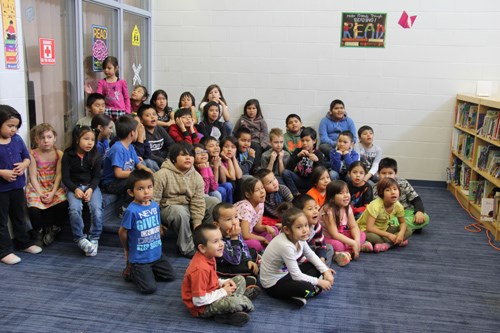As part of her vision-and that of her community-to implement a strong Indigenous Language Program at White Bear Education Complex, Principal Sheri McArthur-Cappo welcomed the Treaty 4 Education Alliance (T4EA) to WBEC on Wednesday, March 25, where representatives worked with students, as part of a program designed to reclaim their community's languages.
Although there are four First Nation languages represented at White Bear-Cree, Nakota, Saulteaux, and Sioux-the school started the program concentrating on Cree.
“The Cree Language Program has been implemented throughout Kindergarten to grade seven,” says McArthur-Cappo. “However, I'm looking forward to developing the other language programs here at White Bear Education Complex, too.”
“The languages will include Saulteaux, Nakota, and Sioux. I'm planning to initiate these other language programs in the fall of 2015,” she says. “I'm also looking forward to offering the language program as a credit class for high school students.”
White Bear has embraced the project, says T4EA consultant, Megaen Reader. “Although the project is aimed at Kindergarten students, students from grades K to eight all participated in presenting a song, a prayer, and a story (in Cree).”
Reader says the project comes out of consultation with elders from the 11 First Nations schools that the T4EA represents.
“The consultations revealed that communities thought more culture and language needed to be taught in schools,” says Reader.
During the March 25 visit to WBEC, students were challenged to learn a song, a prayer, and a story in Cree.
Reader and videographer Paul Lang met with WBEC students, elders, and language instructors. The team recorded the students and language instructors performing the song, prayer, and story chosen by the school. These recordings are used to create resources that the students and the wider White Bear community can use to practice their language skills. These recordings will be made avaiable on iPads as well as on the T4EA website.
Interviews with Elder Nora Kakakaway and fellow elders and language teachers, Josh and Madeline Kakakeway were also recorded, in order to capture their views on the importance of learning and reclaiming traditional languages.
The team also observed a lesson taught to grade three by teacher Brittney Wiley, and Reader says, “They were all very eager and enthusiastic to show off their Cree. The grade seven students we talked to also revealed the same thing, about learning the language.”
“The students said it made them proud to learn Cree and to be able to speak it with their families,” adds Reader.
“Once the students learn the song, prayer, and story, they are tasked with teaching their families and other members of the school and community.The hope is by starting early as spark will be ignited to learn their own language, and will continue throughout their lives.”




